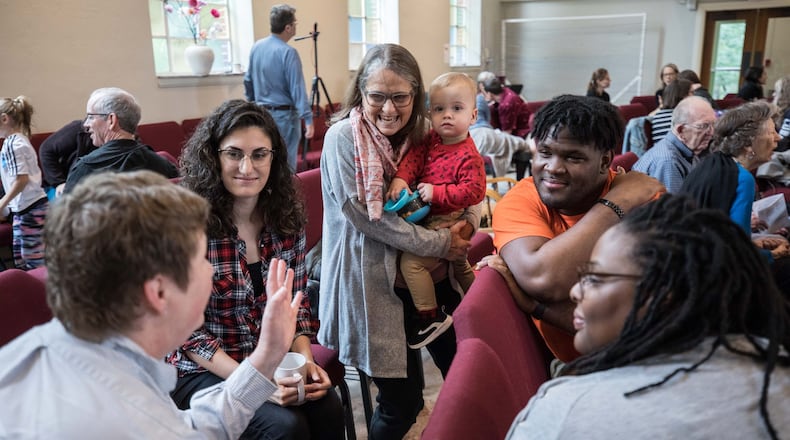At Lovejoy Memorial United Methodist Church in Newnan, there’s row after row of empty pews.
Usually, about 29 people attend Sunday services.
Today, there are 17.
“We had homecoming last Sunday, so that may have something to do with it,” said the Rev. Jack Couch, the church’s 70-year-old part-time pastor.
The pianist is out, so Couch, who is also a professional musician and songwriter, picks up his guitar and leads the congregation in song.
Although Lovejoy’s membership is small, its faith isn’t.
The 114-year-old Lovejoy Memorial is one of the smaller congregations in the North Georgia Conference of the United Methodist Church. Members can trace their family ties to the corner church, located in the heart of what was once a community of mill workers, back generations.
The future direction, though, is uncertain for Lovejoy and roughly 20 smaller congregations in the LaGrange District of the conference.
Members of the 2019 North Georgia Annual Conference recently voted to institute a minimum salary for part-time pastors, according to spokeswoman Sybil Davidson. “Some of these part-time pastors’ salaries have been decreasing while the workload remains the same.”
Churches are responsible to pay that minimum salary of $12,750 to part-time pastors, beginning this January.
Churches who were paying below that minimum were notified in September by the district superintendent of concerns about the continued vitality of their congregations. Those measurements include new baptisms and professions of faith, weekly attendance and outreach ministries.
“The small churches that are not paying that minimum salary are now having to decide how to proceed,” Davidson wrote in an email. “In some instances, there are fewer than 25 people responsible for salaries, buildings and all the responsibilities of a church.”
Davidson said the LaGrange District is mostly rural, but she expects other districts in North Georgia to eventually follow suit.
“It doesn’t mean churches will close. It’s just time to have a conversation about the future,” she said.
Related: UMC decision has many unknowns for churches, members
It’s not just an issue with the United Methodists.
Other mainline denominations have leveled off or seen attendance drop, sometimes precipitously.
The percentage of Americans who say they belong to a church, synagogue or mosque averaged 50%, an all-time low, in 2018, according to Gallup. That’s down from 70% in 1999.
The drop in church membership follows cultural trends that include an increasing proportion of Americans with no religious preference.
In smaller congregations, experts also point to aging membership, as well as people moving out of the area, not going to church or joining larger, more contemporary churches.
Most churches are smaller in size than the megachurches, with thousands of members, that dot the landscape.
In fact, the majority of pastors, many of whom also have full-time jobs, serve their congregations each week with modest compensation and often in rural areas of smaller cities.
The National Association of Evangelicals’ 2017 research of 4,249 evangelical senior pastors found that nearly 80% of pastors serve in congregations with fewer than 200 people, and 55% have fewer than 100 people in their church.
Some congregations are so small, services are led by a layperson, not an ordained pastor.
“We’re just in a place in society right now where it’s more and more difficult for small congregations to sustain a pastor, even a part-time pastor,” said Ron Robinson, a professor of religion at Wofford College in Spartanburg, South Carolina. “Part-time salary minimums are fairly new, but it’s in line with what United Methodists have done for full-time pastors for a while.”
More: Gospel singer Micah Stampley's daughter dies at 15
For churches, options can include merging with another church, using a layperson instead of a pastor or eventually closing.
“Many of the small church pastors I know love the people in the congregations and communities,” he said. “However, they struggle with a lack of resources” in terms of money and people.
Four years ago, discussions began between Druid Hills United Methodist Church and Epworth United Methodist Church to form a new, merged congregation.
Neither church was sustainable on its own.
Druid Hills, which was over a century old, once had as many as 800 people in its pews.
That number dwindled to 80.
Less than a mile away, Epworth UMC, which was founded in 1890, saw its Sunday attendance drop to 25 or 30 people “on a good day.”
“They realized that they would be stronger together,” said the Rev. Andy Woodworth, co-pastor of the 300-member Neighborhood Church in Candler Park, the new church that was formed from the merger. “Neither church alone was able to maintain large enough numbers of members to attain critical mass. It was sort of an arranged marriage, if you will. … What happens with churches is that they get into a place where they can’t imagine what it would take to do church differently and to connect with their community differently. It takes really stepping outside patterns and habits.”
Lovejoy’s Couch became a pastor three years ago and came to Lovejoy in June.
He understands that the conference needs to have statistical evidence that a church is vibrant, but that’s not always about numbers.
Many of the members are ready to “pick up the pace, if that’s the cost of continuing,” he said. “My attitude about growing is not as heavy-handed. The real value of a church is what its people are doing out in the world. Are they being empowered to make the lives around them better?”
John Lager, 76, has been a member for two decades.
He stays because of the closeness of its members.
“I’m not putting down big churches, but we care about each other,” said Lager, who is retired.
“We’re family,” he said.
Another member, Owen Lambert, said the church is “near and dear” to him.
The possibility of closing or merging angers him.
“If a church is able to sustain itself, there’s not reason to close the church,” he said. “Me and my family would not go to a large church. We like a smaller church where you participate, where you’re active. You cut the grass, if necessary. We put the banners up. I’m the treasurer. I’m also an usher.”
When a church merges or closes, there’s no guarantee that members will stay with a particular denomination.
Consider what happened at Poplar Springs United Methodist Church in Adairsville.
In 2017, the then-179-year-old church, located about 60 miles north of downtown Atlanta, closed.
At its height, it had roughly 80 members. At the time of its closing, membership had dwindled to six.
Lynn Smith and other members fought to keep the doors open. When they weren’t successful, the congregation met for a couple of years in a coffee shop, which closed on Sundays. Then they were made an offer to rent to buy another church just 4 miles away.
The new church, Poplar Springs Fellowship Church, is nondenominational, and its Sunday attendance is 30.
The former church property now houses a gas station. The congregation bought the small cemetery, which was across the road and where several of Smith’s relatives are buried, from the annual conference for $1,200.
“We stuck together because we felt like family,” said Smith. “We just weren’t going to let the devil defeat us. The only one who can tell us what to do is God. We don’t follow man’s law; we follow God’s law.”
About the Author
Keep Reading
The Latest
Featured






